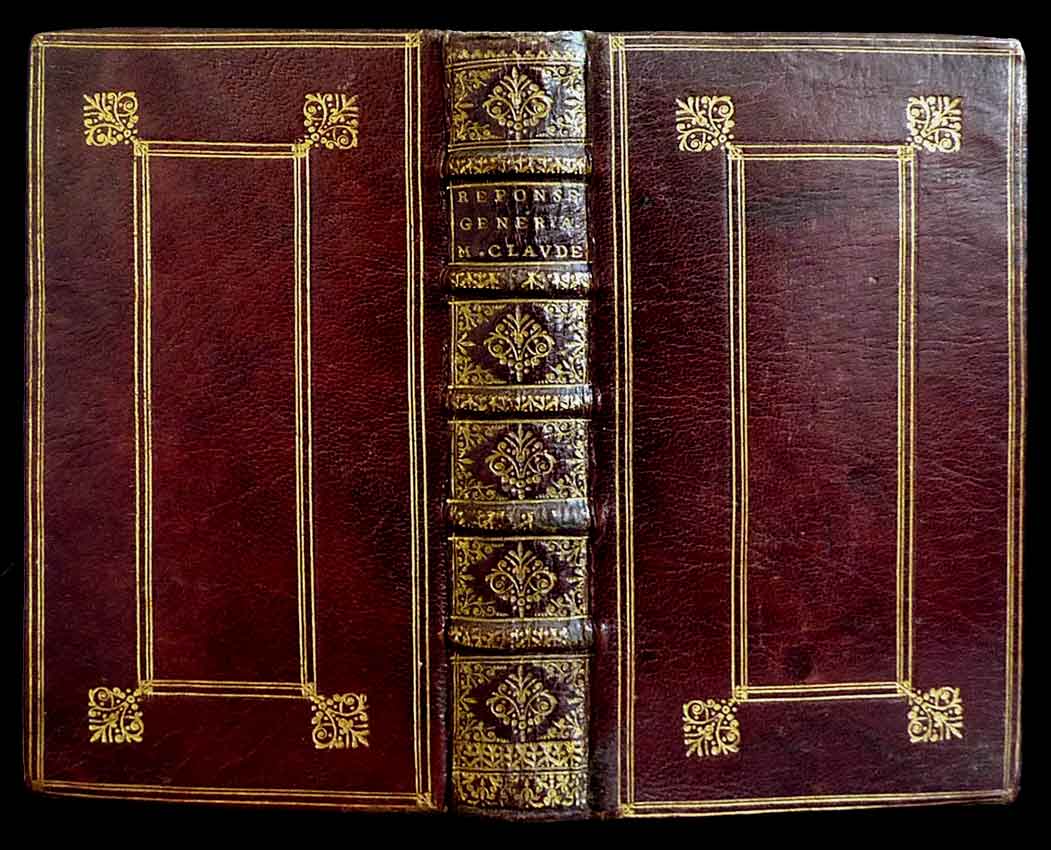


| This binding à la Du Seuil was up for auction recently on eBay (October 04, 2010). The seller's photos were so good that I have used them above. While I didn't recognize the fleuron on the boards nor the tooling on the spine, the inner dentelle looked very much like Boyet's roulette A as illustrated in the 2002 Paris publication by Isabelle de Conihout & Pascal Ract-Madoux, Reliures françaises du XVIIe siècle. In this publication the authors present a number of bindings which they attribute to Boyet and on page 110 they have catalogued some of the tools commonly found on the bindings presented (click here to see an enlargement of page 110.). The type specimens have been reproduced from rubbings, these are shown at their actual size. Below I show the first Boyet binding from their catalogue. It is a rare dated (1695) binding with doublure and on closer inspection we discover that roulette found on the doublure is the one that the authors have chosen as the roulette type B. |


| Of all the imprints they might have chosen from these bindings for their catalogue one wonders why they have presented two nearly identical roulettes as their A and B specimens, and also one might question the advisability of showing these in two completely different orientations? I couldn't resist making a few tests with these roulettes to compare them with the eBay example, and immediately spotted a flaw that was evident in all the examples, this confirmed my suspicions that this ebay binding was a Boyet or at least one of the tools used on the binding was identical to that used by Boyet in 1695. |


| In Comparative Diagram 1, I have assembled all the examples and aligned them with the flaw which is marked with a green arrow. I have rotated the roulette B example so that it is oriented in the same direction as all the others. Here we make an amazing discovery, the type A roulette and the type B roulette are in fact the same roulette! Look at the upper part of the roulette at positions a,b,c, and d. Here we see that the upper details appear to be out of alignment with their corresponding counterparts below, all seem to have been shifted a bit to the right. Also note that the flaw is evident in both A and B examples. The B roulette shows a greater separation of the upper and lower parts, however I suspect that this is due to a join in the leather that has separated, the same feature can be observed in a second doubler shown below . This is another Boyet example reproduced by Isabelle de Conihout & Pascal Ract-Madoux. |


| In as much as we have shown that the Isabelle de Conihout & Pascal Ract-Madoux roulette A and B are the same, it might be better to consider the roulette shown in the doubler above as a candidate for roulette B. In Comparative Diagram 2, I show this roulette together with roulette A, these are presented at the same scale and are very similar. Below I have aligned the strips of roulette B so that they matchup, there is no obvious flaw to help us here. If you click on this diagram you will see a 600 dpi enlargement where there appears a similar separation or cut in the roulette imprints. The example of this roulette that I have chosen for Comparative Diagram 2, is far from perfect however appears to be free of this kind of separation, that may be linked to a join in the leather which is particular to the fabrication of doublures. Considering that an inner dentelle would effectively conceal the join of the doublure leather, it is not surprising that the two appear to go hand in hand. |

| Before closing this page, we should look at some of the other imprints found on our eBay 1671 binding, while these do not strike one immediately as Boyet tools, there are some things that are very familiar, such as the triple fillet with a small tool masking the filet crossings. (Note: it may be that Boyet decided not to use any of his usual tools on this binding, due to the sensitive nature of this strongly Jansenist work by Antoine Arnauld, later known as La perpétuité de la foi de l'Église catholique touchant l'eucharistie.) |




| I include this last photo which gives a better idea of true daylight color and leather condition, this book is over three hundred years old, yet it looks like new. We see here, high quality materials and expert craftsmanship, all the signs of a Boyet! |
|
See also Luc-Antoine Boyet- Roulettes Type C. go to this page to see an example of Boyet roulette E Luc-Antoine Boyet- Jansenist Binding or return to the Boyet Index Page. |
| information about the author | return to the home page of VIRTUAL BOOKBINDING |